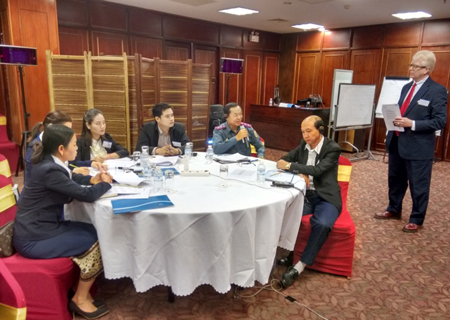|
|
|
|
|
|
|
||||
|
|
||||
|
|
||||

Vientiane, Lao PDR (31 October - 02 November 2017) - Corruption has been identified as a major governance-related risk by the Government of Lao PDR and a priority to be addressed in the 8th National Socio-Economic Development Plan (NSEDP) 2016-2020. The influx of foreign investments, the development of public-private partnership initiatives, and the implementation of mega projects pose major corruption risks, and corruption and illicit financial flows divert a large amount of resources from the national budget. In fact, Lao PDR, together with three other countries from Asia (Bangladesh, Nepal and Myanmar) appears in the top 20 least-developed countries (LDCs) list with the highest level of illicit outflows. In Lao PDR, illicit financial outflows constitute 14.42% of the GDP, well above the average (4.8% of GDP) for the 39 LDCs ranked (excluding 3 from Asia-Pacific). This presents a major impediment to the social and economic development of Lao PDR.
In order to address these challenges Laotian Authorities expressed a number of technical assistance and capacity building needs. In particular, they highlighted their need for assistance in regards to Article 36 of the UN Convention Against Corruption, with regard to conducting corruption and financial investigations. Stakeholders also highlighted the need for a better coordination, cooperation and sharing of information between all relevant national authorities involved in addressing corruption cases, such as the police, prosecutors, FIU and the MSP.
The "Training on Financial Investigations in Lao PDR", held from 31 October to 02 November 2017 in Vientiane, Lao PDR, addressed the identified capacity-building needs. In a three-day workshop, 40 participants from the SIAA, police, Anti-Money-Laundering Intelligence Office (AMLIO) and the Supreme People's Prosecutor Office learned about financial investigation methods, developed a Laotian financial investigation tool-kit and applied the newly acquired skills by solving hypothetical corruption cases. The cases required participants from different agencies to cooperate with each other. Representatives from the ANZ bank and the AMLIO also shared with the participants what type of financial information their respective institutions collect and how law enforcement agencies can obtain them to support their on-going investigations.
Mr. Erlend Audunson Falch, Officer in Charge and Alternative Development Coordinator of the UNODC Lao PDR Office highlighted that "an independent and strong anti-corruption authority in charge of preventing and combating corruption offences is the backbone of a successful anti-corruption strategy. Addressing corruption successfully is also crucial for promoting rule of law and democratic institutions and decision-making. It serves to protect human rights and people's liberties, provides a check on other branches of government, and helps secure an environment conducive to economic growth and social progress".
In the light of this, the training of national investigators and prosecutors on conducting investigations of corruption offences, including financial investigations, was fundamental to further strengthening the capacity of national law enforcement authorities. Through a combination of presentations and practical group work exercises, participants were given training in understanding best international practice, both in the general approach to conducting corruption investigations as well as in the specific application of a vast range of investigatory techniques. Special focus was given on the application of special investigation techniques, including the conduct of undercover operations, so-called "sting" operations, the use of electronic evidence, and the "expenditures" method for ascertaining corruption-related conduct. In working groups, participants were provided with a scenario describing a corruption-related complaint and asked to draft and execute an investigator strategy, which required participants to "follow the money" of corruption-related money acquired by a bribe-taker. In this exercise, participants had to apply all investigatory tactics learned in this training, follow-up on approximately seventeen investigatory leads, and calculate the potential corruption-related income to the bribe-taker. Feedback has shown that participants found the workshop very relevant to their work and enhanced their knowledge and skills.